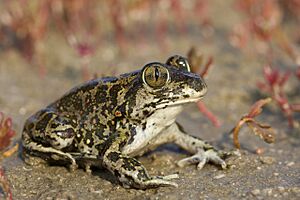Syrian spadefoot facts for kids
Quick facts for kids Syrian spadefoot |
|
|---|---|
 |
|
| Eastern spadefoot toad | |
| Conservation status | |
| Scientific classification | |
| Genus: |
Pelobates
|
| Species: |
syriacus
|
The eastern spadefoot (Pelobates syriacus) is a special kind of toad. It's also called the Syrian spadefoot. These toads belong to a family called Pelobatidae. You can find them living in parts of Eastern Europe and Western Asia.
Contents
What Does the Eastern Spadefoot Look Like?
The eastern spadefoot is a plump toad. It has a big head with a flat top. Its eyes are large and stick out, and its pupils look like vertical slits. This toad can grow to be about 9 centimeters (about 3.5 inches) long.
Its skin is smooth, but it has a few small warts. Male toads have a large gland behind their front legs. This gland gets bigger during the breeding season.
The front feet have four toes. The back feet have five toes with deep webbing between them. The back legs are short. On the back of each hind foot, there's a yellowish, bony bump. This bump is called a "spade," and it helps the toad dig. That's how it got its name!
The color of these toads can change a lot. Their back is often pale grey with large, green, uneven spots. Their belly is usually pale grey.
You can tell the eastern spadefoot apart from other spadefoot toads. The western spadefoot (Pelobates cultripes) has a black spade. The common spadefoot (Pelobates fuscus) has a domed (rounded) head, but the eastern spadefoot's head is flat.
Where Do Eastern Spadefoot Toads Live?
The eastern spadefoot lives in many countries. These include Armenia, Azerbaijan, Bulgaria, Georgia, Greece, Iran, Israel, Lebanon, Macedonia, Romania, Russian Federation, Serbia, Syria, and Turkey.
They are quite common in Iran. However, they are not very common in most other places. Scientists think they might be gone from Jordan. Their status is not clear in Albania, Iraq, Moldova, and Ukraine. Recently, they were found in the West Bank at Wadi Qana.
What Kind of Home Do They Like?
Eastern spadefoot toads like to live in light woodlands. They also live in bushy areas, semi-deserts, and even farmlands. They prefer loose soil because they use their spades to dig burrows. These burrows are where they live.
Sometimes, you can find them in rocky areas or pebbly clay soils too. The places where eastern spadefoot toads live depend on the temperature and rainfall. They don't like areas that are too cold in summer or have too much rain.
Also, they need large ponds without fish for their tadpoles to grow. This is because their tadpoles are quite big!
What Does the Eastern Spadefoot Sound Like?
The eastern spadefoot has a unique call. They usually make this sound underwater. It often continues all night long. Their call is a fast, short "clock...clock...clock" sound. You can hear it from far away!
Daily Life of the Eastern Spadefoot
The eastern spadefoot is a nocturnal animal. This means it is active at night. After looking for food, it returns to the same hiding spot every night. They eat molluscs (like snails), spiders, insects, and other small arthropods.
They dig their own burrows. But sometimes, they might use a hole made by a rodent or a crack under a rock. When the weather is very hot, they go deep into their burrows. They might even go into a deep sleep called aestivation during mid-summer. Toads living near moist riverbanks often do better during hot times. If there's a drought, many toads might not survive.
In winter, they go into a deep sleep called hibernation. They hide among tree roots or under rocks. Sometimes, several toads huddle together to stay warm.
Life Cycle and Reproduction
Breeding happens from February to May. The exact time depends on where the toads live. They like to lay their eggs in ditches and still pools of water.
A female toad can lay several thousand eggs. These eggs are in wide, jelly-like bands. These bands can be 2 centimeters (about 0.8 inches) thick and 1 meter (about 3 feet) long.
The tadpoles hatch after about three days. They eat algae and water plants. They grow for three or four months. After this, they change into young toads. This change is called metamorphosis. Many young toads dig into the mud at the edge of ponds to spend the winter. Some tadpoles might even stay tadpoles through the winter!
How Are Eastern Spadefoot Toads Doing?
The eastern spadefoot is listed as "Least Concern" by the IUCN Red List. This means they are not currently in great danger. The biggest problem they face is losing their homes. This happens when land use changes or when breeding areas are drained.
They live in many places and are thought to have a large population. Even though their living areas are a bit spread out, their numbers are not dropping too quickly. So, they don't need to be in a more threatened group. However, some groups of these toads can be in danger of disappearing locally, especially in dry areas.
See also
 In Spanish: Sapo de espuelas sirio para niños
In Spanish: Sapo de espuelas sirio para niños
Images for kids




